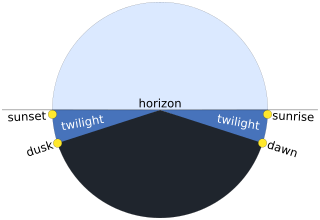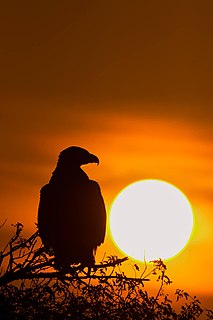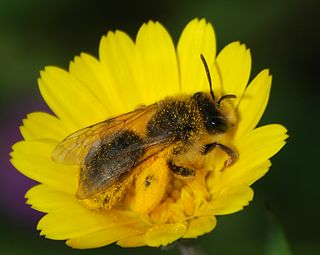The Kali Yuga, in Hinduism, is the fourth and worst of the four yugas in a Yuga Cycle, preceded by Dvapara Yuga and followed by the next cycle's Krita (Satya) Yuga. It is believed to be the present age, which is full of conflict and sin.

Sunset, also known as sundown, is the daily disappearance of the Sun below the horizon due to Earth's rotation. As viewed from everywhere on Earth, the equinox Sun sets due west at the moment of both the Spring and Autumn equinox. As viewed from the Northern Hemisphere, the sun sets to the northwest in the Northern hemisphere's spring and summer, and to the southwest in the autumn and winter; these seasons are reversed for the Southern Hemisphere.

Dawn is the time that marks the beginning of twilight before sunrise. It is recognized by the appearance of indirect sunlight being scattered in Earth's atmosphere, when the centre of the Sun's disc has reached 18° below the observer's horizon. This morning twilight period will last until sunrise, when direct sunlight outshines the diffused light.

Dusk occurs at the darkest stage of twilight, or at the very end of astronomical twilight after sunset and just before night. At predusk, during early to intermediate stages of twilight, enough light in the sky under clear conditions may occur to read outdoors without artificial illumination; however, at the end of civil twilight, such lighting is required to read outside. The term dusk usually refers to astronomical dusk, or the darkest part of twilight before night begins.

A crepuscular animal is one that is active primarily during the twilight period, being matutinal, vespertine, or both. This is distinguished from diurnal and nocturnal behavior, where an animal is active during the hours of daylight and of darkness, respectively. Some crepuscular animals may also be active by moonlight or during an overcast day. Matutinal animals are active only before sunrise, and vespertine only after sunset.

Twilight is the illumination of the lower atmosphere when the Sun is not directly visible because it is below the horizon. Twilight is produced by sunlight scattering in the upper atmosphere, illuminating the lower atmosphere so that Earth's surface is neither completely lit nor completely dark. The word twilight is also used to denote the periods of time when this illumination occurs.

A sunbeam, in meteorological optics, is a beam of sunlight that appears to radiate from the position of the Sun. Shining through openings in clouds or between other objects such as mountains and buildings, these beams of particle-scattered sunlight are essentially parallel shafts separated by darker shadowed volumes. Their apparent convergence in the sky is a visual illusion from linear perspective. The same illusion causes the apparent convergence of parallel lines on a long straight road or hallway at a distant vanishing point. The scattering particles that make sunlight visible may be air molecules or particulates.

The Indian nightjar is a small nightjar which is a resident breeder in open lands across South Asia and Southeast Asia. Like most nightjars it is crepuscular and is best detected from its characteristic calls at dawn and dusk that have been likened to a stone skipping on a frozen lake - a series of clicks that become shorter and more rapid. They are sometimes spotted on roads when their eyes gleam red in the spotlight of a vehicle. There is considerable plumage variation across its range and can be hard to differentiate from other nightjars in the region especially in the field.

Evening is the period of a day from the end of the afternoon to the beginning of night. The exact times when evening begins and ends depend on location, time of year, and culture, but it is generally regarded as beginning when the Sun is low in the sky and lasting until the end of twilight. Depending on the speaker, it may start as early as 5 or 6 pm, and to last until night or bedtime. It may be used colloquially to include the last waning afternoon shortly before sunset.

The Dvapara Yuga, in Hinduism, is the third and third best of the four yugas in a Yuga Cycle, preceded by Treta Yuga and followed by Kali Yuga. Dvapara Yuga lasts for 864,000 years.

Diurnality is a form of plant and animal behavior characterized by activity during daytime, with a period of sleeping or other inactivity at night. The common adjective used for daytime activity is "diurnal". The timing of activity by an animal depends on a variety of environmental factors such as the temperature, the ability to gather food by sight, the risk of predation, and the time of year. Diurnality is a cycle of activity within a 24-hour period; cyclic activities called circadian rhythms are endogenous cycles not dependent on external cues or environmental factors except for a zeitgeber. Animals active during twilight are crepuscular, those active during the night are nocturnal, and animals active at sporadic times during both night and day are cathemeral.

The blue hour is the period of twilight when the Sun is at a significant depth below the horizon. During this time, the remaining sunlight takes on a mostly blue shade. This shade differs from the colour of the sky on a clear day, which is caused by Rayleigh scattering.

The Andrenidae are a large, nearly cosmopolitan family of solitary, ground-nesting bees. Most of the family's diversity is located in temperate or arid areas. It includes some enormous genera. One of the subfamilies, Oxaeinae, is so different in appearance that they were typically accorded family status, but careful phylogenetic analysis reveals them to be an offshoot within the Andrenidae, very close to the Andreninae.

The Antillean nighthawk is a nightjar native to the Caribbean and Florida Keys.
In the study of chronobiology, entrainment occurs when rhythmic physiological or behavioral events match their period to that of an environmental oscillation. It is ultimately the interaction between circadian rhythms and the environment. A central example is the entrainment of circadian rhythms to the daily light–dark cycle, which ultimately is determined by the Earth's rotation. Exposure to certain environmental stimuli will cue a phase shift, and abrupt change in the timing of the rhythm. Entrainment helps organisms maintain an adaptive phase relationship with the environment as well as prevent drifting of a free running rhythm. This stable phase relationship achieved is thought to be the main function of entrainment.

Matutinal, matinal, and matutine are terms used in the life sciences to indicate something of, relating to, or occurring in the early morning. The term may describe crepuscular animals that are significantly active during the predawn or early morning hours. During the morning twilight period and shortly thereafter, these animals partake in important tasks, such as scanning for mates, mating, and foraging.

Ōmagatoki – a Japanese term referring to the moment at Tasogare, when the sky grows dark. The opposite of Tasogare is Akatsuki, Ōmagatoki has specific meanings for the two ways of writing it: first, "the time of meeting Yōkai, Yūrei, and other-such dark creatures"; and second, "the Time of Great Calamity".
Pycna semiclara, known as the Whining Forest Cicada, is a South African forest-dwelling platypleurine cicada.

















